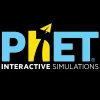Take a look inside 7 images
PhET Interactive Simulations
Pros: Variety of topics and target ages, and a ton of support materials.
Cons: Not as compelling as real-world simulations; design is somewhat dated; requires teacher input and direction (not really student self-guided).
Bottom Line: Instantly add meaningful lab experiences to math and science classrooms for free? It's tough to beat that.
There's no shortage of ways to use PhET Interactive Simulations in (or out of) the classroom. Effectively, any time you'd use a static PowerPoint slide or textbook image to demonstrate a science or math concept, it's worth checking PhET to see if there's an interactive version. Chances are high that there's already one on the site. There are also virtual versions of common lab experiences, and it might be worth using the simulation if you're short on class time or resources, or if you're doing distance learning. Even if you have really great videos of experiments, the interactivity of these simulations can contribute so much to your lessons that it's hard not to use both.
Especially for science teachers struggling with 45-minute class times, PhET can be a great way for students to experience labs at home. There are hundreds of complete lesson plans and resources available on the site (with a free account) that use the site's simulations. The simulations work in a browser, or you can also download them for offline use. You can also use them as-is or, with a bit of know-how, remix them for your needs. Just be sure to share your modifications with the rest of the community! Keep in mind, though, that many of these simulations are not designed for students to lead themselves in the learning; they require teacher input and direction, including what the various functions of many of the sims are for and how they work.
With over 100 different simulations available, PhET Interactive Simulations is a large collection of virtual experiments, demonstrations, and visualizations for dozens of math and science topics (from early elementary through post-secondary school). Each tool allows students to control a variety of parameters for each concept, tinkering and exploring and probing relationships—all from the safety and comfort of a computer. The results are displayed in real time, often with relevant data to make the outcomes even clearer. All simulations are rendered in HTML5, Flash, or Java, and updates have been made so that they all work in modern browsers. There's also a paid app available (for iOS and Android) that includes a collection of about 75 HTML5 simulations (note: the Java and Flash sims are not included, and some of the accessibility features from the website are not available).
Every simulation is accompanied by a large cache of teacher- and expert-created classroom resources, including lab guides, homework, and assessments; you just have to create a free account to access them. Furthermore, all tools, and many teacher resources, are available in dozens of languages. Some of the simulations have even been made with various accessibility issues in mind, and many allow students with accessibility issues to participate more fully than they might be able to with real-world models. Teachers can also upload their own activities under the Creative Commons license (so PhET doesn't own them, and anyone can use and alter them for their own classrooms).
PhET Interactive Simulations is an excellent, free tool to help support student learning. Lab experiments and demonstrations have been a staple of math and science since the dawn of time for a very good reason: They promote lasting retention of otherwise difficult-to-understand concepts. Research into learning and cognition has also shown that when learners actively control, tinker with, and push the boundaries of live experiences, the learning is even deeper and more meaningful. In that way, PhET is an exceptional tool for learning. These simulations can illuminate some of the very toughest topics in math and science in ways that paragraphs of text, equations, textbook pictures, and even videos of demonstrations just can't touch.
In addition to some dated designs and clunky navigations that can distract from otherwise excellent simulations, some of the tools are a bit too closed-ended and could benefit from additional controls. In addition, some of the simulations are incredibly simple and would serve only as a quick demonstration of the concept, not an in-depth discovery. These both may be due to limitations of the technology when the tools were designed, so as tools are updated to modern standards, this could change.

















